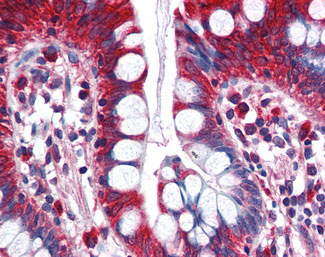ACS5 / ACSL5 Antibody (C-Terminus)
Goat Polyclonal Antibody
- SPECIFICATION
- CITATIONS
- PROTOCOLS
- BACKGROUND

Application
| WB, IHC-P, E |
|---|---|
| Primary Accession | Q9ULC5 |
| Reactivity | Human, Monkey |
| Host | Goat |
| Clonality | Polyclonal |
| Calculated MW | 76kDa |
| Dilution | ELISA (1:16000), IHC-P (2.5 µg/ml), WB (1-3 µg/ml) |
| Gene ID | 51703 |
|---|---|
| Other Names | Long-chain-fatty-acid--CoA ligase 5, 6.2.1.3, Long-chain acyl-CoA synthetase 5, LACS 5, ACSL5, ACS5, FACL5 |
| Target/Specificity | Human ACSL5. This antibody is expected to recognise isoform a (NP_057318.2) and isoform b (NP_976313.1 and NP_976314.1). |
| Reconstitution & Storage | Store at -20°C. Minimize freezing and thawing. |
| Precautions | ACS5 / ACSL5 Antibody (C-Terminus) is for research use only and not for use in diagnostic or therapeutic procedures. |
| Name | ACSL5 (HGNC:16526) |
|---|---|
| Function | Catalyzes the conversion of long-chain fatty acids to their active form acyl-CoAs for both synthesis of cellular lipids, and degradation via beta-oxidation (PubMed:17681178, PubMed:22633490, PubMed:24269233, PubMed:33191500). ACSL5 may activate fatty acids from exogenous sources for the synthesis of triacylglycerol destined for intracellular storage (By similarity). Utilizes a wide range of saturated fatty acids with a preference for C16-C18 unsaturated fatty acids (By similarity). It was suggested that it may also stimulate fatty acid oxidation (By similarity). At the villus tip of the crypt- villus axis of the small intestine may sensitize epithelial cells to apoptosis specifically triggered by the death ligand TRAIL. May have a role in the survival of glioma cells. |
| Cellular Location | Mitochondrion. Endoplasmic reticulum. Mitochondrion outer membrane; Single-pass type III membrane protein Endoplasmic reticulum membrane; Single-pass type III membrane protein. Cell membrane |

Thousands of laboratories across the world have published research that depended on the performance of antibodies from Abcepta to advance their research. Check out links to articles that cite our products in major peer-reviewed journals, organized by research category.
info@abcepta.com, and receive a free "I Love Antibodies" mug.
Provided below are standard protocols that you may find useful for product applications.
Background
Acyl-CoA synthetases (ACSL) activate long-chain fatty acids for both synthesis of cellular lipids, and degradation via beta-oxidation. ACSL5 may activate fatty acids from exogenous sources for the synthesis of triacylglycerol destined for intracellular storage (By similarity). Utilizes a wide range of saturated fatty acids with a preference for C16-C18 unsaturated fatty acids (By similarity). It was suggested that it may also stimulate fatty acid oxidation (By similarity). At the villus tip of the crypt-villus axis of the small intestine may sensitize epithelial cells to apoptosis specifically triggered by the death ligand TRAIL. May have a role in the survival of glioma cells.
References
Gassler N.,et al.Gastroenterology 133:587-598(2007).
Clark H.F.,et al.Genome Res. 13:2265-2270(2003).
Ota T.,et al.Nat. Genet. 36:40-45(2004).
Suzuki Y.,et al.Submitted (APR-2005) to the EMBL/GenBank/DDBJ databases.
Deloukas P.,et al.Nature 429:375-381(2004).
If you have used an Abcepta product and would like to share how it has performed, please click on the "Submit Review" button and provide the requested information. Our staff will examine and post your review and contact you if needed.
If you have any additional inquiries please email technical services at tech@abcepta.com.













 Foundational characteristics of cancer include proliferation, angiogenesis, migration, evasion of apoptosis, and cellular immortality. Find key markers for these cellular processes and antibodies to detect them.
Foundational characteristics of cancer include proliferation, angiogenesis, migration, evasion of apoptosis, and cellular immortality. Find key markers for these cellular processes and antibodies to detect them. The SUMOplot™ Analysis Program predicts and scores sumoylation sites in your protein. SUMOylation is a post-translational modification involved in various cellular processes, such as nuclear-cytosolic transport, transcriptional regulation, apoptosis, protein stability, response to stress, and progression through the cell cycle.
The SUMOplot™ Analysis Program predicts and scores sumoylation sites in your protein. SUMOylation is a post-translational modification involved in various cellular processes, such as nuclear-cytosolic transport, transcriptional regulation, apoptosis, protein stability, response to stress, and progression through the cell cycle. The Autophagy Receptor Motif Plotter predicts and scores autophagy receptor binding sites in your protein. Identifying proteins connected to this pathway is critical to understanding the role of autophagy in physiological as well as pathological processes such as development, differentiation, neurodegenerative diseases, stress, infection, and cancer.
The Autophagy Receptor Motif Plotter predicts and scores autophagy receptor binding sites in your protein. Identifying proteins connected to this pathway is critical to understanding the role of autophagy in physiological as well as pathological processes such as development, differentiation, neurodegenerative diseases, stress, infection, and cancer.


